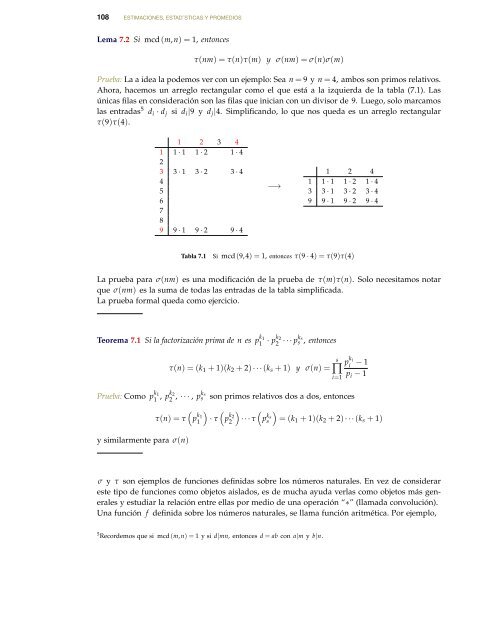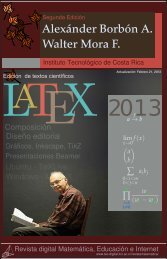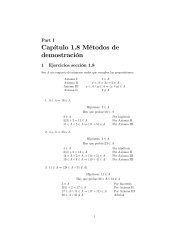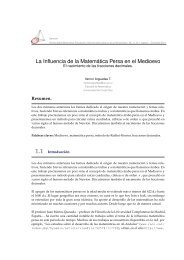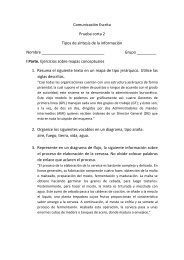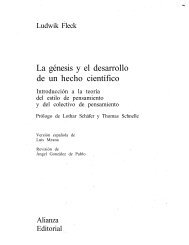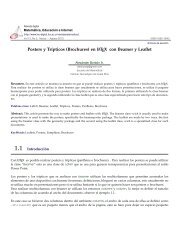Introducción a la teoría de números. Ejemplos y - TEC-Digital
Introducción a la teoría de números. Ejemplos y - TEC-Digital
Introducción a la teoría de números. Ejemplos y - TEC-Digital
You also want an ePaper? Increase the reach of your titles
YUMPU automatically turns print PDFs into web optimized ePapers that Google loves.
108 ESTIMACIONES, ESTAD˝STICAS Y PROMEDIOS<br />
Lema 7.2 Si mcd(m,n) = 1, entonces<br />
τ(nm) = τ(n)τ(m) y σ(nm) = σ(n)σ(m)<br />
Prueba: La a i<strong>de</strong>a <strong>la</strong> po<strong>de</strong>mos ver con un ejemplo: Sea n = 9 y n = 4, ambos son primos re<strong>la</strong>tivos.<br />
Ahora, hacemos un arreglo rectangu<strong>la</strong>r como el que está a <strong>la</strong> izquierda <strong>de</strong> <strong>la</strong> tab<strong>la</strong> (7.1). Las<br />
únicas fi<strong>la</strong>s en consi<strong>de</strong>ración son <strong>la</strong>s fi<strong>la</strong>s que inician con un divisor <strong>de</strong> 9. Luego, solo marcamos<br />
<strong>la</strong>s entradas 5 d i · d j si d i|9 y d j|4. Simplificando, lo que nos queda es un arreglo rectangu<strong>la</strong>r<br />
τ(9)τ(4).<br />
1 2 3 4<br />
1 1 · 1 1 · 2 1 · 4<br />
2<br />
3 3 · 1 3 · 2 3 · 4<br />
4<br />
5<br />
6<br />
7<br />
8<br />
9 9 · 1 9 · 2 9 · 4<br />
−→<br />
1 2 4<br />
1 1 · 1 1 · 2 1 · 4<br />
3 3 · 1 3 · 2 3 · 4<br />
9 9 · 1 9 · 2 9 · 4<br />
Tab<strong>la</strong> 7.1 Si mcd(9,4) = 1, entonces τ(9 · 4) = τ(9)τ(4)<br />
La prueba para σ(nm) es una modificación <strong>de</strong> <strong>la</strong> prueba <strong>de</strong> τ(m)τ(n). Solo necesitamos notar<br />
que σ(nm) es <strong>la</strong> suma <strong>de</strong> todas <strong>la</strong>s entradas <strong>de</strong> <strong>la</strong> tab<strong>la</strong> simplificada.<br />
La prueba formal queda como ejercicio.<br />
Teorema 7.1 Si <strong>la</strong> factorización prima <strong>de</strong> n es p k 1<br />
1<br />
Prueba: Como p k 1<br />
1<br />
y simi<strong>la</strong>rmente para σ(n)<br />
· pk2<br />
2 · · · pks s , entonces<br />
τ(n) = (k1 + 1)(k2 + 2) · · · (ks + 1) y σ(n) =<br />
s<br />
∏<br />
i=1<br />
p ki i − 1<br />
pi − 1<br />
, pk2<br />
2 , · · · , pks s son primos re<strong>la</strong>tivos dos a dos, entonces<br />
�<br />
τ(n) = τ p k � �<br />
1<br />
1 · τ p k2<br />
� �<br />
2 · · · τ p ks<br />
�<br />
s = (k1 + 1)(k2 + 2) · · · (ks + 1)<br />
σ y τ son ejemplos <strong>de</strong> funciones <strong>de</strong>finidas sobre los <strong>números</strong> naturales. En vez <strong>de</strong> consi<strong>de</strong>rar<br />
este tipo <strong>de</strong> funciones como objetos ais<strong>la</strong>dos, es <strong>de</strong> mucha ayuda ver<strong>la</strong>s como objetos más generales<br />
y estudiar <strong>la</strong> re<strong>la</strong>ción entre el<strong>la</strong>s por medio <strong>de</strong> una operación “∗” (l<strong>la</strong>mada convolución).<br />
Una función f <strong>de</strong>finida sobre los <strong>números</strong> naturales, se l<strong>la</strong>ma función aritmética. Por ejemplo,<br />
5 Recor<strong>de</strong>mos que si mcd(m,n) = 1 y si d|mn, entonces d = ab con a|m y b|n.


